Read Reviews
The Best Raised Beds
-
best overall - Land Guard Galvanized Raised Garden Bed Kit
-
best for vegetables - VegTrug Medium Raised Bed Planter
-
best value raised bed - Selections Metal Raised Vegetable Beds
-
best plastic raised bed - Garland Raised Grow Bed
-
best square raised bed - Aoodor Raised Garden Bed
-
best wooden raised bed - The Chamberlain Wooden Raised Grow Bed by Lacewing™
-
best raised bed for balconies - Keter Easy Growing Raised Garden Bed
-
best for practicality - Vegtrug Natural Raised Planter
-
best self watering raised bed - Outsunny Set of 4 Garden Raised Bed
-
best greenhouse-alternative - GEEZY Raised Garden Bed Planter Box
Raised Bed Reviews
1. Land Guard Galvanized Raised Garden Bed Kit[ SAVE 18% ]
best overall
- Takes just 20 minutes to assemble and this is very easy
- Although not particularly thick, this raised bed should last a good few years
- Feels sturdy and solid once constructed
- Won’t rust thanks to the galvanised layer, even after heavy rainfall
- Rolled top means that once assembled it’s not sharp
- Edges of the metal pieces can be sharp so a lot of care needs to be taken during assembly
- Metal is fairly thin - can’t put any weight on the sides once assembled or it may bend
- Material
- Galvanised metal
- Shape
- Oval
- Dimensions
- 121 x 61 x 30 cm
- Weight
- 4.57 kg
- Design
- 5
- Ease of Setup
- 4.5
- Material Quality
- 4.5
- Value for Money
- 5
Made from galvanised metal, the Land Guard Galvanised Raised Garden Bed Kit is a long lasting bed and my top pick for the best raised garden bed overall. The double layer of anti-corrosion galvanising ensures this raised bed will be a long lasting addition to your garden.
The corrugated construction gives this raised bed an industrial look that pairs beautifully with brightly coloured flowers, fruits and vegetables. The oval shape provides a less formal aesthetic than square or rectangular beds, making this a lovely choice for more relaxed garden settings.
It measures 121 x 61 x 30 cm. It doesn’t take up too much space, and is instead a good ‘medium’ size bed, suitable for most gardens. You’ll still be able to easily access the centre of the bed.
It takes just 20 minutes to set up, and the base is open so it can be used to plant deep rooted plants, as well as shallow rooted herbs and vegetables. Take care when assembling this bed, as the edges are very sharp.
It weighs just 4.57 kg, which means it’s lightweight enough to move around the garden. The metal isn’t particularly thick, so you’ll need to be careful not to lean on the edges during installation. Once set up and filled with soil, it feels a lot sturdier.
Stylish, long lasting and available in a range of colours, this raised bed is our top choice for most gardens.
Did you find this review helpful?
2. VegTrug Medium Raised Bed Planter[ SAVE 12% ]
best for vegetables
- Fairly straight forward to assemble despite some of the edges not lining up
- Height of 80 cm is a good working height - suitable for elderly gardeners and those with limited mobility
- 42 cm depth allows you to plant deep rooted fruits and vegetables
- Wood has been treated with a food safe preservative so it can be used to grow edible produce with no concerns
- Instructions are very small so will be hard for anyone with poor eyesight to read
- Material
- Wood
- Shape
- Rectangular
- Dimensions
- 183 x 76 x 80 cm
- Weight
- Not listed
- Design
- 5
- Ease of Setup
- 4
- Material Quality
- 4
- Value for Money
- 4
If you’ve always dreamed of having your own herb or vegetable garden, the VegTrug Medium Raised Bed Planter is a great place to start. Neat and compact, this raised bed planter is perfect for homegrown herbs and veggies.
It has plastic caps on the feet which make it perfect for patios, so you could install it just outside of your kitchen for easy access to your homegrown produce.
It measures 80 cm tall, which makes it a comfortable height for most gardeners, including children. Elderly gardeners don’t need to stoop low to access their plants, while it’s also the perfect height for wheelchair users.
It can be placed on any surface, used to transform balconies, small deckings and rooftop terraces, allowing those with smaller outdoor spaces in urban areas to develop their green thumb.
There’s a V-shaped base with a depth of 42 cm. This should be ample space for most herbs and veggies.
It arrives treated with a food-safe preservative, but this will need reapplying once a year. It comes with replaceable fitted membrane liner which will also help to protect the wood underneath.
All in all, this is one of the best raised garden beds if you’re after a quirky raised planter specifically designed for edible produce. While the depth does mean you’re marginally restricted with what you can grow, it’s an excellent choice if you’re after a smaller herb garden that can be installed anywhere.
Did you find this review helpful?
3. Selections Metal Raised Vegetable Beds
best value raised bed
- Powder coated sides won’t rust over time
- Easy to assemble in around 30 minutes
- 100 x 100 cm area gives enough space to grow a range of plants but still allows for easy access to the middle of the bed
- Sides feel a little thin and flimsy until the bed has been put together
- The sides have sharp edges so a lot of care is needed when assembling
- Material
- Steel
- Shape
- Square
- Dimensions
- 100 x 100 x 30 cm
- Weight
- 7 kg
- Design
- 4
- Ease of Setup
- 4
- Material Quality
- 4
- Value for Money
- 4
Metal is a great choice for raised beds thanks to its informal appearance and durability. The Selections Metal Raised Vegetable Bed measures 100 x 100 x 30 cm and is the perfect size for a small vegetable garden. Even better, there’s two of these beds included.
These raised beds are made from strong but lightweight steel, painted in green to ensure they blend in against your plants and lawn. While they measure 30 cm tall, they can be dug further into the soil if you’d like them a little lower to the ground.
They can be put together in 30 minutes, with all nuts and bolts included. Each part is good quality, with a powder coating to prevent rust from forming. Although the sides feel a little flimsy, once put together they are fairly robust.
These raised beds can be installed on any surface although they don’t come with a base. This gives you more options when it comes to planting, allowing you to grow deep-rooted plants as well as shallow. Some users have chosen to line the beds with cardboard or a plastic liner to help reduce the growth of weeds.
All in all, these raised beds are great value for money and a good option for smaller vegetable gardens.
Did you find this review helpful?
4. Garland Raised Grow Bed
best plastic raised bed
- Can be put together within 15 minutes
- Simple square design suits most gardens
- Feels very robust once constructed
- A good size to make multiple smaller vegetables beds
- Black sides can help to insulate the soil
- Doesn’t have the same aesthetic appeal as wooden raised beds
- Material
- Plastic
- Shape
- Square
- Dimensions
- 97.5 x 97.5 x 25 cm
- Weight
- Not listed
- Design
- 4
- Ease of Setup
- 4.5
- Material Quality
- 4
- Value for Money
- 4
Plastic raised beds are practical and low maintenance, withstanding poor weather without needing regular treatment. The Garland Raised Grow Bed is loved for its simplicity. This square raised bed measures 97.5 x 97.5 x 25 cm, and has a capacity of 230 L.
Made from 100% recycled materials, this raised bed is ideal for those looking to shop sustainably. It’s very durable, requiring no maintenance once installed, and it can be left out in all weathers.
While delivered in separate pieces, this bed is fairly easy to assemble in around 15 minutes. The corners simply snap together and can be secured using the included pins. Once secured, it’s attractive, robust and suitable for all sorts of plants.
With black sides, this raised bed should help to insulate the soil. On warm days, the black sides will help keep the warmth in, which will likely enable you to start planting earlier in the season.
If you’re after an affordable raised bed that requires no maintenance once installed, this Garland bed is well worth considering.
Did you find this review helpful?
5. Aoodor Raised Garden Bed
best square raised bed
- 120 x 120 cm interior is spacious enough for a range of plants but still allows for easy access to the centre of the bed
- Can be assembled in around 30 minutes fairly easily
- Green finish looks good in most gardens and allotments
- Lightweight at just 5.4 kg so can be moved to the perfect spot in the garden once assembled
- Not particularly sturdy until it’s been filled with soil
- Material
- Steel
- Shape
- Square
- Dimensions
- 120 x 120 x 30 cm
- Weight
- 5.4 kg
- Design
- 4.5
- Ease of Setup
- 4
- Material Quality
- 4
- Value for Money
- 4
The Aoodor Raised Garden Bed is a smart and simple raised bed, perfect for smaller gardens and allotments. It measures 120 x 120 cm, so you’ll be able to access all the plants without leaning on the surrounding soil.
At 30 cm high, this bed raises plants only slightly off the ground. It’ll add vertical interest to your garden but it’s low enough that it won’t cost too much to fill with a good quality topsoil.
At 120 x 120 cm, this raised bed is spacious enough to grow a number of plants, while still offering gardeners access to the very middle of the bed. If you prefer a rectangular raised bed, there’s also a 120 x 60 cm size available.
It’s very easy to assemble and comes with all screws included. It can be assembled in around 30 minutes, although it’s worth noting that it isn’t particularly sturdy until it’s been filled with soil.
Being made from powder coated metal, this raised bed is durable and rust-resistant.
Overall, this raised bed is a popular and reliable choice. It’s easy to put together, while the 120 x 120 cm size is ideal for most gardens, offering ample space for planting while still ensuring you can reach all areas of the bed.
Did you find this review helpful?
6. The Chamberlain Wooden Raised Grow Bed by Lacewing™[ SAVE 41% ]
best wooden raised bed
- Smart wooden design looks good in any garden
- Measures 100 x 100 cm which is a reasonable size but still allows you access to the middle of the bed
- Pressure treated so should last a long time before needing treating again
- Although pressure treated, it’s best to use a liner if you’re going to be growing edible produce
- The 20 cm height won’t make gardening any more comfortable as you may still need to kneel on the ground
- Material
- Wood
- Shape
- Square
- Dimensions
- 100 x 100 x 20 cm
- Weight
- 16 kg
- Design
- 5
- Ease of Setup
- 3.5
- Material Quality
- 4.5
- Value for Money
- 4
Wooden raised beds are popular for a reason; they offer a charming, natural look that suits both formal and informal garden settings. For larger outdoor spaces, the Chamberlain Wooden Raised Grow Bed by Lacewing™ is perfect.
This bed measures 100 x 100 x 20 cm. While it may not make tending to your plants any more comfortable (unlike waist-high garden beds), it still offers ample benefits. Its practical size ensures it’s easy for gardeners to reach the plants at the very centre of the bed without disturbing the surrounding soil.
The smooth wooden finish not only looks beautiful, it should also help warm the soil up faster on hot days. If installed in a sunny spot, this can even extend the growing season. It’s suitable for sloping gardens, as you can simply install it deeper into the soil on one side.
It’s been pressure treated for resistance against rot and bad weather, but you will need to treat it again every year or so. This is one of the downsides of wood. Unlike metal and plastic raised beds, wooden beds do require maintenance. If you’re growing vegetables, it’s essential that the treatment is food-safe, or you’ll need to purchase a liner.
It’s fairly easy to assemble, with the parts simply slotting together, but you do need a hammer. Most gardeners find they are able to assemble the bed in under 30 minutes.
All in all, this raised bed is for those who love a natural wood finish and don’t mind the extra maintenance that comes with this material. It’s smart, simple and will add vertical interest to your garden.
Did you find this review helpful?
7. Keter Easy Growing Raised Garden Bed
best raised bed for balconies
- Compact construction is perfect for small spaces and balconies
- 75.7 cm tall which is a comfortable working height - easier to tend to plants without stooping over
- Easy to assemble - simply slot the legs into place
- Overflow caps help to regulate the water, reducing the chances of overwatering
- Not particularly sturdy once assembled - best used in sheltered areas
- Material
- Plastic
- Shape
- Rectangular
- Dimensions
- 114 x 49.3 x 75.7 cm
- Weight
- 9.62 kg
- Design
- 4.5
- Ease of Setup
- 5
- Material Quality
- 3.5
- Value for Money
- 4
The Keter Easy Growing Raised Garden Bed is the best raised bed for small outdoor spaces or balconies. It measures 114 x 49.3 x 75.7 cm, which makes it large enough to grow a variety of vegetables, but it’s not so big that it’ll overwhelm the space.
The elevated design means it’s comfortable to use, eliminating the need to bend over. The natural, round rattan design is stylish and durable. It doesn’t require any treatment or maintenance, yet it’s more aesthetically pleasing than a generic plastic bed.
It’s suitable for growing a variety of plants thanks to the drainage tap and overflow caps which help regulate the watering. This allows excess water to drain through easily, reducing the chances of overwatering and subsequent root decay. The elevated growing conditions will prevent pests from being able to access your plants, while also preventing weeds from growing up from underneath.
With a 120 L capacity, you’ll be able to grow a variety of herbs, fruits and vegetables, but it shouldn’t cost a huge amount to fill this raised bed with good quality soil.
This bed is very easy to assemble; simply slot the legs into place. Once assembled, it’s weather resistant but best installed in a sheltered spot if you live in a particularly windy area.
If you’re looking for a compact and elegant raised bed for smaller outdoor spaces or balconies, this rattan style raised bed is a reliable choice.
Did you find this review helpful?
8. Vegtrug Natural Raised Planter
best for practicality
- Practical design with a storage shelf at the bottom for watering cans or plant feed
- Comes with a liner included so can be used to grow vegetables or herbs
- Can be painted with weatherproof paint to brighten it up
- A good size for a range of vegetables including root vegetables which require more space
- The 80 cm height makes it more comfortable to tend to your plants, especially if you are elderly, a wheelchair user or have limited mobility
- Some strength and DIY skills are required during assembly
- Although the shelf is very practical, it’s not particularly sturdy and shouldn’t be used to store very heavy items
- Material
- Wood
- Shape
- Rectangular
- Dimensions
- 78 x 58 x 80 cm
- Weight
- 8 kg
- Design
- 5
- Ease of Setup
- 3.5
- Material Quality
- 4
- Value for Money
- 4
Practical and stylish in equal measure, the Vegtrug Natural Raised Planter has a natural look and a compact design.
The shelf at the bottom is a welcome touch, and can be used to store watering cans or plant feed. It holds 110 L of compost, so there’s plenty of space for tomatoes as well vegetables with deeper roots.
When growing edible produce in a raised planter, it’s important that there’s no harmful chemicals on the bed material which could leach into the soil. This planter has been treated with a food-safe preservative so you can plant herbs and veggies with no concerns. While this means there’s no need for a liner, there is one included, which can help elongate the lifespan of the wood.
Measuring 80 cm tall, this planter is a comfortable height for most users. Harvesting, weeding and watering vegetables will be far easier, although taller gardeners may still need to stoop.
It weighs 8 kg, so it’s lightweight enough to move around the garden if needed, yet it remains sturdy in strong winds.
The wooden construction of this planter makes it an attractive addition to any garden, and it’s particularly charming in smaller spaces like balconies or smaller patios.
Did you find this review helpful?
9. Outsunny Set of 4 Garden Raised Bed[ SAVE 40% ]
best self watering raised bed
- Self watering feature is ideal for forgetful gardeners - plants are watered as and when they need it
- Has the look of rattan with the durability of plastic
- Rattan design complements most garden furniture
- While some parts are stiff, it’s fairly easy to put together
- Some of the parts are awkward to click into place
- Plugs arrive loose in the bags so care is needed when tipping out the parts
- Material
- Plastic
- Shape
- Square
- Dimensions
- 40 x 40 x 44 cm
- Weight
- 3.9 kg
- Design
- 5
- Ease of Setup
- 3.5
- Material Quality
- 4
- Value for Money
- 4
If you’re prone to over or under watering, the Outsunny Garden Raised Bed set should be at the top of your list. These four raised beds have a traditional rattan design as well as a self-watering system that’ll protect plants from forgetful or over-zealous gardeners!
With 4 included, this set is very good value for money. The rattan effect blends with most styles of garden furniture. Two of the beds have legs which raise them 44 cm off the ground, while the other two are lower, allowing you to create a space-efficient and stylish two-tier garden.
Each planter has a thick plastic body which can cope with all seasons. There’s no maintenance required, nor any chance of rust – one of the primary benefits of a plastic bed!
For gardeners who regularly forget to water their plants, the intelligent water disc will be an invaluable feature. The disc reserves water and feeds flowers, herbs and plants as and when they need it.
It’s worth mentioning that the assembly isn’t particularly straightforward. Once you’ve put together one bed, the others are easier, but some parts are stiff to click into place. Even so, each bed can be assembled in around 15 minutes.
Overall, this is the best raised bed if you’re after a set of beds that maximise space in smaller areas. The self-watering feature makes this set the perfect choice for busy gardeners!
Did you find this review helpful?
10. GEEZY Raised Garden Bed Planter Box
best greenhouse-alternative
- Lid helps keep plants warm and extend your planting season
- Very simple to assemble - simply attach the legs to the body
- 2 kg weight means it’s easy to move around once assembled
- Can be used either with or without the legs
- While there are drainage holes in the legs, more may need to be drilled if you live in a very rainy area
- Material
- Plastic
- Shape
- Rectangular
- Dimensions
- 38 x 77 x 84 cm
- Weight
- 2 kg
- Design
- 4.5
- Ease of Setup
- 5
- Material Quality
- 4
- Value for Money
- 4
Perfect for those without space for a greenhouse, the GEEZY Raised Garden Bed Planter Box is for those looking to grow plants which require more warmth. It comes with a plastic lid and ventilation system which will help keep the interior warmer on sunny days.
The plastic lid has the added benefit of protecting plants from bad weather. It’s ideal for seedlings which prefer warmer temperatures, or plants that aren’t frost-hardy. The lid can help take the edge off frosty nights.
Measuring 64 cm tall (without the lid), this planter box is a comfortable working height. It’s 38 cm wide and 77 cm long so, while it’s not enormous, it’s ideal for those without a lot of planting space. There’s 25 cm of space for the roots, so it’s suitable for most shallow-rooted herbs and vegetables.
It has a black, oval construction that helps to keep the interior warmer. There’s no need to worry about weather deterioration nor regular maintenance.
There’s drainage holes in the legs of this planter, but it can be used without the legs if needed. Weighing just 2 kg, it’s easy to move to a sunny spot, even once filled with soil.
All in all, this is the best raised garden bed if it’s a mini greenhouse you require. It’ll keep plants protected from all weathers, while the included lid offers a huge range of benefits to your plants.
Did you find this review helpful?
Compare Product Features
Use the dropdown to sort the table by the feature you want to see.
Land Guard Galvanized Raised Garden Bed Kit
- 4.8
- Galvanised metal
- Oval
- 121 x 61 x 30 cm
- 4.57 kg
VegTrug Medium Raised Bed Planter
- 4.3
- Wood
- Rectangular
- 183 x 76 x 80 cm
- Not listed
Selections Metal Raised Vegetable Beds
- 4
- Steel
- Square
- 100 x 100 x 30 cm
- 7 kg
Garland Raised Grow Bed
- 4.1
- Plastic
- Square
- 97.5 x 97.5 x 25 cm
- Not listed
Aoodor Raised Garden Bed
- 4.1
- Steel
- Square
- 120 x 120 x 30 cm
- 5.4 kg
The Chamberlain Wooden Raised Grow Bed by Lacewing™
- 4.3
- Wood
- Square
- 100 x 100 x 20 cm
- 16 kg
Keter Easy Growing Raised Garden Bed
- 4.3
- Plastic
- Rectangular
- 114 x 49.3 x 75.7 cm
- 9.62 kg
Vegtrug Natural Raised Planter
- 4.1
- Wood
- Rectangular
- 78 x 58 x 80 cm
- 8 kg
Outsunny Set of 4 Garden Raised Bed
- 4.1
- Plastic
- Square
- 40 x 40 x 44 cm
- 3.9 kg
GEEZY Raised Garden Bed Planter Box
- 4.4
- Plastic
- Rectangular
- 38 x 77 x 84 cm
- 2 kg
How to Choose the Best Raised Garden Bed
Raised beds offer a number of advantages over traditional in-ground beds, and are particularly well suited to smaller gardens. They allow you to plant more in a smaller space, while also enabling you to introduce better quality soil to your garden.
Not sure where to start? Here’s all you need to know about raised beds for your garden.
The Benefits of a Raised Garden Bed
Raised beds offer a number of benefits to gardeners, but perhaps the biggest advantage is that they can be placed anywhere and on any surface.
Raised beds can be used to cover eyesores, make the most of unused space or create an entranceway. Raised planter boxes can be placed anywhere in your garden to frame or add interest to a certain area.
Raised beds are also much more space efficient. You can fill them with better quality soil than the soil that naturally occurs in your garden, which means all plants are able to access the nutrients they need. As there’s less competition for nutrients, you’ll be able to grow more in a smaller space.
You’ll also have full control over the soil you use. Select a soil that’s compatible with what you’re growing, and your plants will benefit from a better yield and increased resistance to disease.
Finally, raised beds make gardening more comfortable. Taller raised beds are easier for those with limited mobility or wheelchair users to tend to.
READ NEXT: The Best Plants for Raised Garden Beds
What to Look For in a Raised Bed
There’s a few things to look out for when it comes to a raised bed. Construction material, size and drainage all need considering.
Construction Material
You’ve got a huge amount of choice when it comes to the material of your raised bed, and each material has unique advantages.
Timber is loved for its affordability, easy installation and versatility. It can be cut to any size, height and shape to fit your garden. Readymade timber raised beds are usually very affordable. The downside of wood is that it requires regular maintenance, and you’ll need to ensure the treatment is food-safe if you’re going to be growing edible produce.
Metal is another good choice. Metal is easy to maintain and durable provided it’s been treated against rust. Galvanised metal can last up to 30 years. Metal has the added benefit of insulating the soil, which can allow you to start planting earlier.
READ NEXT: Are galvanised steel garden beds safe?
If you’re on a budget, plastic beds are worth considering. These can be very stylish, often with the look of rattan. Plastic is also weather-resistant, requires zero maintenance and lasts a fairly long time.
If you’re wanting to do something a little different in your garden, go for natural, raw wood such as twigs and sticks. You could even get hold of bricks or old pallets and build the raised bed yourself. Take a look at this post on the best materials for raised beds if you’re after some more inspiration
Selecting the Right Size Raised Bed
The best size for your raised beds will depend on the size of your garden, as well as what you’re planning on growing.
It’s important that you’re able to access all parts of the raised bed without disturbing the soil. For this reason, it’s recommended that your bed is a maximum of 120 cm x 120 cm. This size will allow you to reach the plants in the middle without having to lean on the soil. Any bigger, and you may struggle to reach the middle of the bed.
If the bed can only be accessed from one side (for instance, if it’s placed against a garden fence or wall), it should be no more than 60 cm wide. Any wider, and you may struggle to reach the far side of the bed without disturbing the soil.
Raised garden beds can be built to any length, but a couple of shorter beds tends to be more efficient. This provides you with a cut through, as otherwise you’ll need to walk the whole way around a long bed, potentially while carrying a watering can or heavy tools.
Finally, think about the depth. The optimum depth depends on what you are growing and the surface your raised bed will be placed on. Most vegetables won’t require more than 40 cm, while herbs require less.
While deep beds are more expensive to fill, they will require less watering in the summer and allow you more options when it comes to planting.
If your garden bed is going to be placed on your lawn, the depth isn’t quite so important. The plants will be able to root down into the ground beneath if they need more space.
Choosing The Best Design For Your Garden
Traditional raised beds are either rectangular or square, but many gardeners are going against the grain with oval or round raised beds instead. These give your garden a less formal and rigid appearance, with curved borders actually giving the illusion of more space.
Tiered raised beds are very space efficient, allowing you to plant more in a smaller area. These are great for gardeners with a smaller outdoor space. Triangular raised beds are another space efficient option, allowing you to make the most of an unused corner.
Alternatively, consider a raised planter box. These are easy to move to a different spot if needed and can be placed anywhere in the garden. Raised planter boxes are often the most comfortable to tend to.
READ NEXT: The Best Raised Garden Bed Plans
Selecting The Right Soil to Use
There’s a fair amount of debate about the best soil to use for a raised garden bed, and rightly so!
Your choice of soil can have a huge impact on the health and happiness of your plants. Good soil can improve disease resistance, increase the yield and reduce the amount of labour required. Poor soil can damage the health of your plants and lead to a poorer yield.
The best soil for your bed does really depend on what you’re growing. However, as a rule of thumb you should fill a raised bed with 60% topsoil, 30% compost and 10% potting soil. This is sufficient for most raised beds.
To improve the soil, you can add compost, soil amendments and fertilisers. These will add nutrients to the soil while also improving its structure, helping it to retain water and essential nutrients.
Take a look at this post on the best soil for raised beds if you’re struggling.
Raised Bed FAQs
Lining your raised bed can reduce weed growth, improve drainage and prevent any chemicals on the material of your raised bed from leaching into the soil.
If you’re wanting to use natural materials, waste materials from the garden such as grass clippings, straw, leaves or stones are good options. These still allow for good drainage, while clippings, straw and leaves will break down into the soil to improve its quality.
A man-made plastic lining can also be used. This is a good choice if your raised bed has been treated with a preservative that could potentially leach into the soil.
This depends on what you are growing. While some plants need a lot of space for their roots, others have shallow root systems.
As a rule of thumb, you should aim for soil which is around 30 cm deep. Vegetables such as tomatoes, cucumbers or kale require more space – up to 60 cm for their roots.
If you’re planning on growing a raised bed herb garden, you shouldn’t need more than around 15 cm of space.
There aren’t many disadvantages of raised beds, but there’s certainly a couple of things to consider.
The first is the cost. Raised beds can cost money to build, especially if you’re installing more than one. Picking up cheap materials will reduce the cost, but they will still cost money to fill.
Raised beds also require more frequent watering than regular beds. As the soil is exposed on all sides to the sun, it dries out faster, meaning you’ll need to water more often.
You can grow almost any plant in a raised bed, but you do need to think about the spread of the roots as well as the size of the plant. Some plants don’t do well being grown next to others, so you need to make sure that any plant is compatible with the one grown next to it.
The best vegetables for raised beds include carrots, kale, tomatoes, cucumbers, lettuce and celery. Fruits that love raised beds are strawberries, raspberries and watermelon.
If you want to grow perennials in your raised beds, opt for salvias, clematis, Siberian irises and daylilies. Almost any herb can be grown too, including mint, lavender and rosemary.
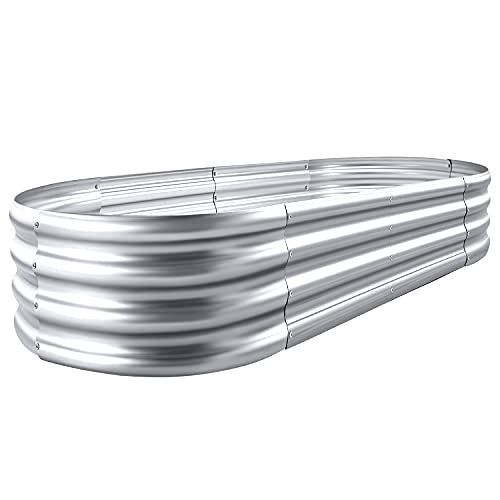
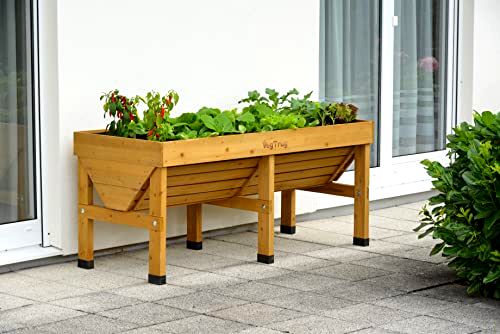
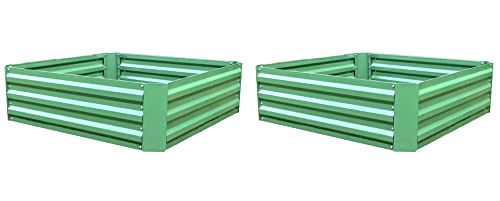

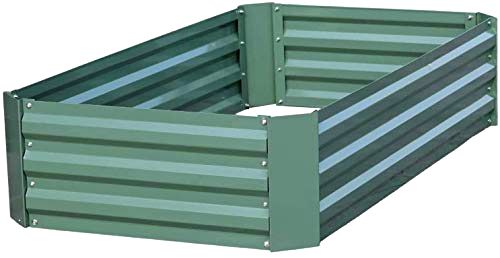
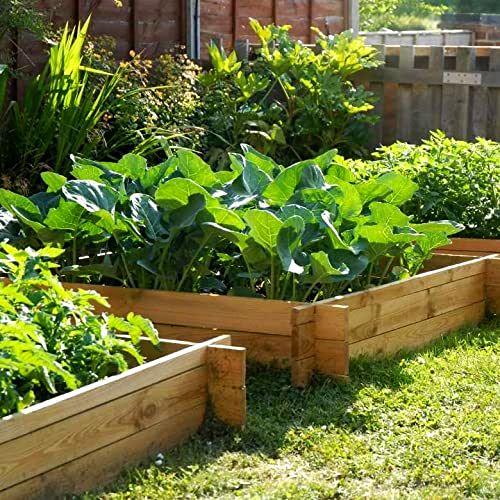
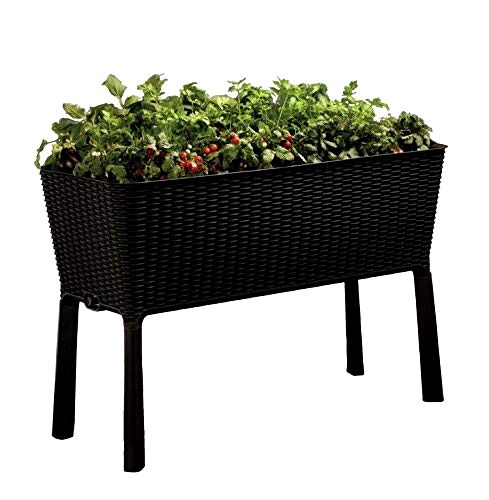
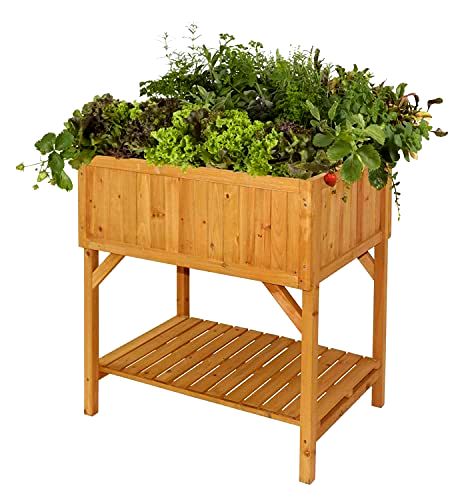
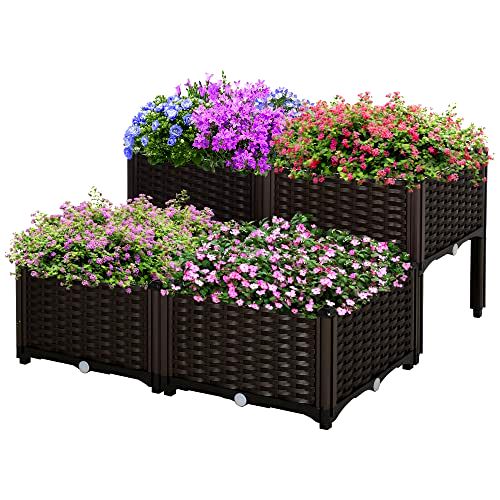
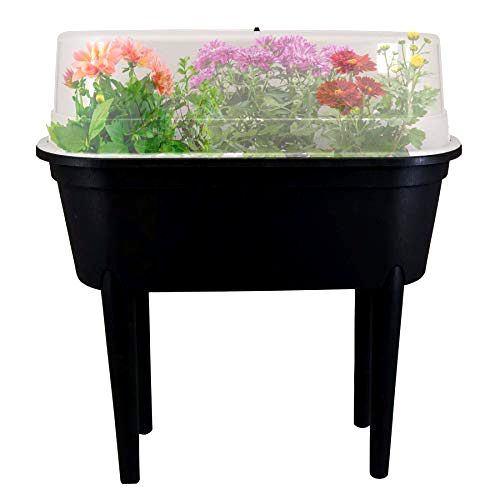

Share